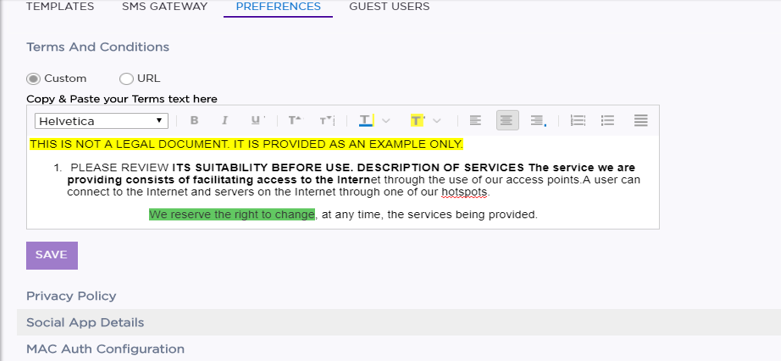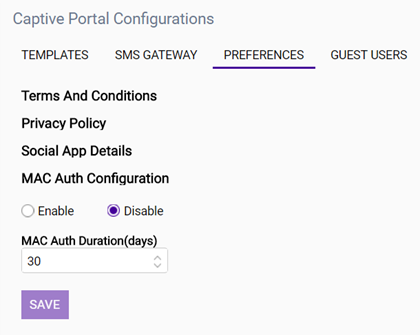
Note
The Terms and Conditions link displays on the Splash and Success panes.To configure captive portal preferences:

| Custom | Enables a custom Terms and Conditions message that displays when a user logs in to the captive portal. HTML terms are editable and can be formatted. |
| URL | Enables an external URL that displays a Privacy Policy when a user logs in to the captive portal. |
| Copy and paste your text here | Enter the terms and conditions that you want to display when a user selects the Terms and Conditions link. A default Terms and Conditions message is displayed. Change the content and edit the formatting to meet your requirements. HTML terms are editable and can be formatted using the standard editing tools, such as Bold, Underline, Font Color, Highlighting, Text Placement, Bulleted List, and so on. |
| External URL | This field displays only when URL is selected. Enter the complete path to the external web page that contains the privacy policy that displays when a user logs in to the captive portal. |
| Custom | Enables a custom Terms and Conditions message that displays when a user logs in to the captive portal. HTML terms are editable and can be formatted. |
| URL | Enables an external URL that displays a Privacy Policy when a user logs in to the captive portal. |
| Copy and paste your text here | Enter the terms and conditions that you want to display when a user selects the Terms and Conditions link. A default Terms and Conditions message is displayed. Change the content and edit the formatting to meet your requirements. HTML terms are editable and can be formatted using the standard editing tools, such as Bold, Underline, Font Color, Highlighting, Text Placement, Bulleted List, and so on. |
| External URL | This field displays only when URL is selected. Enter the complete path to the external web page that contains the privacy policy that displays when a user logs in to the captive portal. |

Twitter - Set the Callback URL to https://cp.ezcloudx.com/auth/twitter/callback
